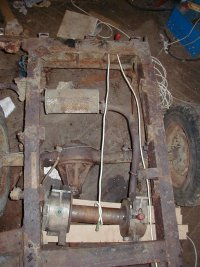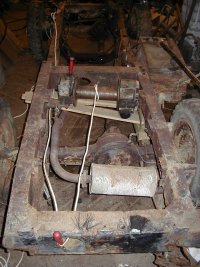Although I want to built this vehicle to be able to climb over most
things there will undoubtedly come a time when forward progress - or
progress in ay direction for that matter - becomes impossible. This is
when a winch comes in handy.
I managed to obtain an ex-electricity board Fairey hydraulic drum
winch that was fitted on a 110. This is a PTO winch with a hydraulic
motor attached. Unfortunately the pump and PTO mechanism was designed to
fit the LT77 gearbox as found in a 110, rather than a Series box.
I ended up exchanging the pump for a fairly complete series IIa Land
Rover.
While helping a local farmer, I noticed a derelict combine harvester
rotting quietly in a corner. After digging a lot of assorted junk out of
the way I found that it had a belt driven hydraulic pump. The farmer
said I could have the pump if he could borrow my arc welder for a couple
of weeks. That is the sort of price I like! It will either be mounted
on the engine with a belt drive or driven directly off the crank with a
dog clutch. The fan belt already has to drive the 100A
alternator/welder and the power steering so putting another load on it
could cause problems..
The most common place to fit a winch is on the front bumper but this
has several disadvantages:
The winch sticks out the front and restricts the approach angle.If you
dive nose-first into a bog then the winch is the first part of the
vehicle to get buried.
Winches are heavy and mounting all that weight right out on the front
puts quite a strain on the suspension.
You usually get stuck when driving forwards. With a front mounted winch
your only option is to pull yourself further into the muck.
A front mounted winch is ideal if you do actually want to pull yourself deeper into
the muck, or if you want to pull someone else out.
Mounting the winch on the rear tends to affect the load space and is no
use if you want to winch forwards. Some people have two winches, one at
the front and one at the rear. This is nice but a lot of extra weight
and cost. My solution is to mount the winch in the middle. The winch
will sit under the floor just behind the rear bulkhead, facing
backwards. The cable will then go round a removeable pulley block
mounted in the rear crossmember, round a guide pulley and along the left
hand chassis rail and out the front. To winch forwards the cable is
pulled out the front and used in the same way as a front mounted winch.
To winch backwards the cable is secured to the front of the vehicle and
the pulley block is pulled out the back. This is an idea copied from
the Foers Ibex The
down side is that there is more chance of the cable getting tangled up
due to the rather tortuous path it takes.
I have held the winch in place on the donor vehicle's chassis and there
is just enough room if I raise the floor of the rear load space by about
2". The cable will go past the left hand engine mount with approx 1/4"
of clearance


The white flex gives you an idea of how the cable will be routed. The
cable will run over a pulley to make sure it clears the exhaust. As in
these pictures the winch will be at a slight angle to the crossmember.
This is so that the cable meets the drum at as close to 90 degrees as
possible. The red handle on the winch will be shortened and operated
with a push-pull cable from the cab.
The hydraulic spool valve has a push pull cable remote. The spool will
be mounted in the cab with the remote on the right hand wing.
Home